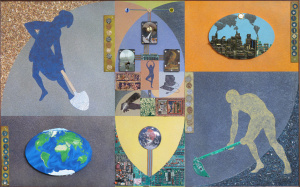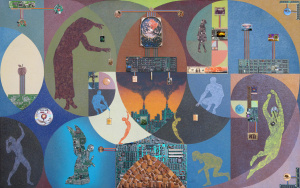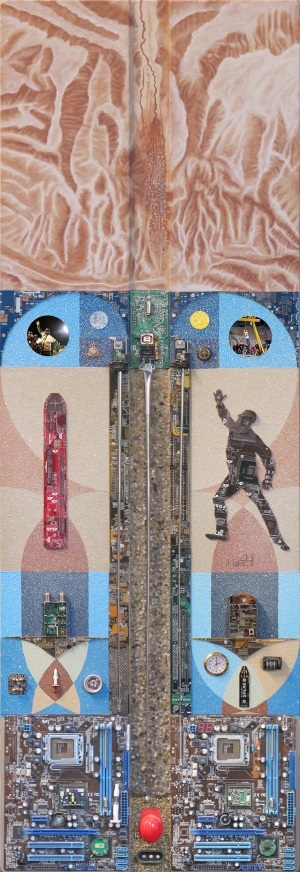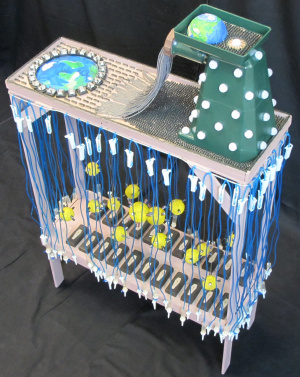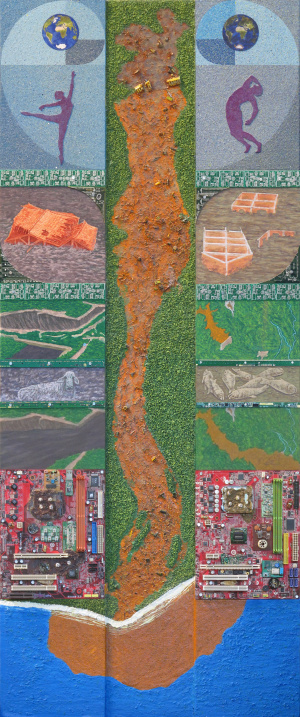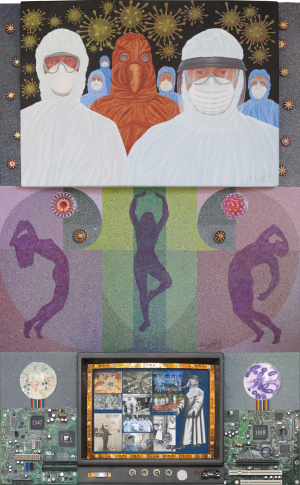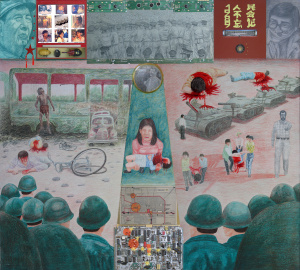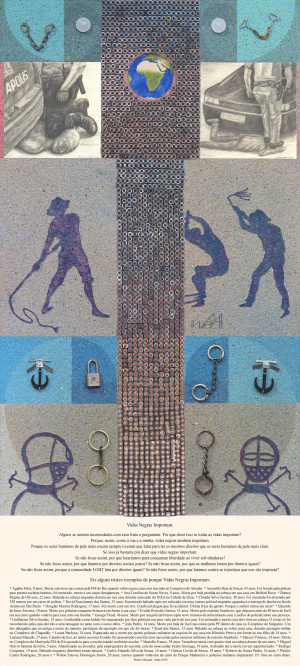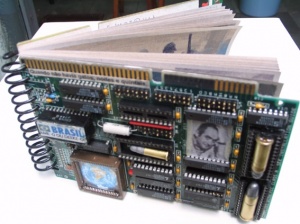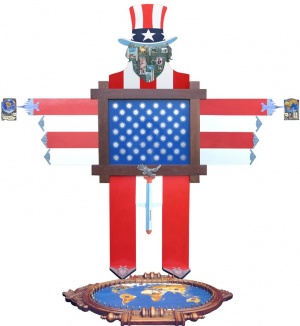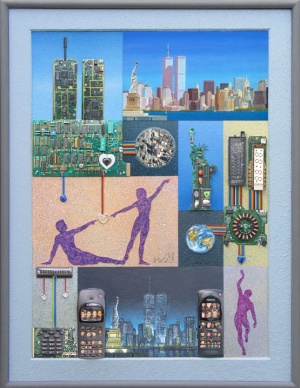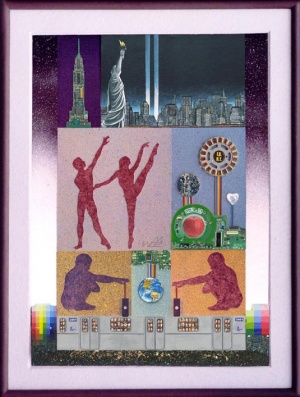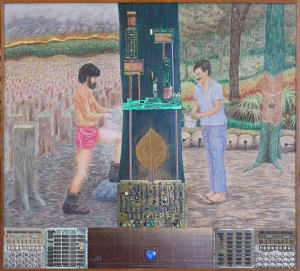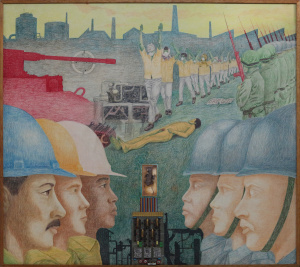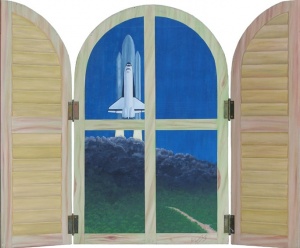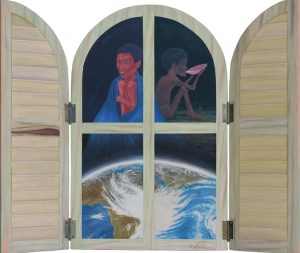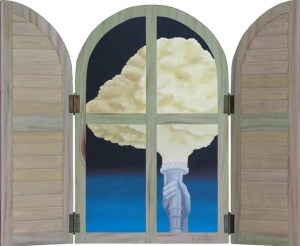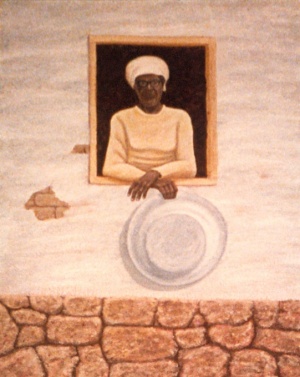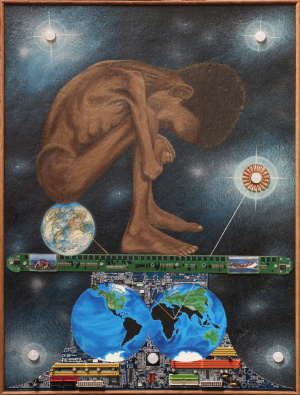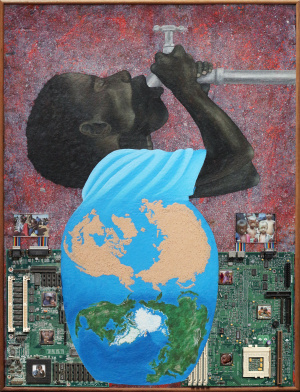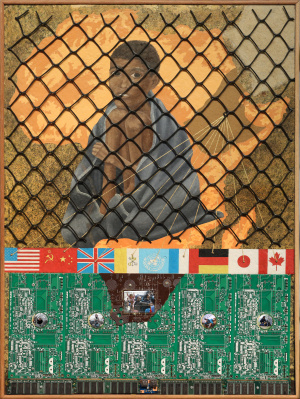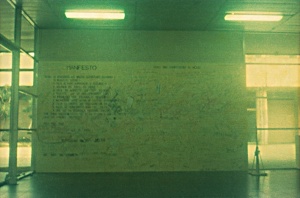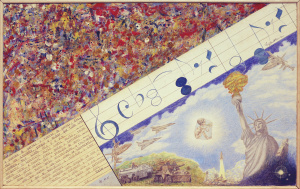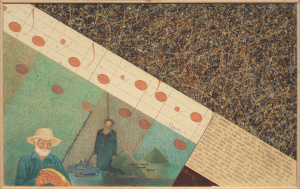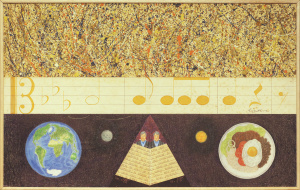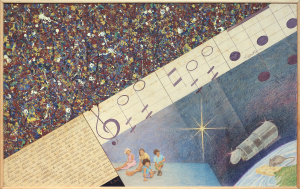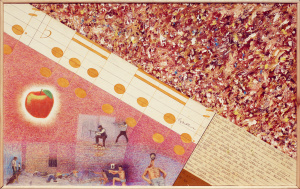1984 - GEORGE ORWELL'S STIGMA
Between 83 and 84, I painted the series of paintings called 1984 - George Orwell's Stigma. It is an analogy of the book 1984, written by Orwell, with contemporary societies. The series shows the inertia of people who allow themselves to be manipulated by those in power through force and information. In it, I painted people with faceted faces to show the robotization of the human being, who does not question the impositions of the political/economic systems and, therefore, becomes indirectly responsible for the inconsequences practiced by the dominators, which are represented in pictures by the words written on the shop signs.
Given the topicality of the theme, it is worthwhile to extend further on the subject. With regard to the book, there are many theses about Orwell's intentions when writing the book 1984. Perhaps he identified London and Labor Party in 1948 after the war. Perhaps he represented communism, fascism, Nazism or, who knows, he was even making a prediction. In my view, these theses are irrelevant in view of the problems addressed by him and that we live concretely through the perversions of power (today and at any time). The title could even be 1964, 1999 or 2020, because more than a prediction, some of the issues addressed by Orwell are easily seen in both post-war and current society, keeping some differences due to technological development, namely:
• control of the individual,
• invasion of individual privacy,
• annulment of peoples' memory,
• changing the meaning of words,
• transforming people into non-beings,
The themes mentioned above can be exemplified as follows:
CONTROL OF THE INDIVIDUAL
Official information agencies, including those in the most "democratic" countries, like the United States, have complete dossiers on the actions of some individuals in society, in a form of "invisible control". The "relative democracies" of the third world implant delation at all social levels, sacrificing even the innocent. Few have the courage to help their partners or who suffered injustice, because behind the delation are torture and terror, whose function is to change and control the conscience of everybody in order to get social “Peace”. These "democracies" keep thought’s police forces that, through totalitarian propaganda and other artifices, manage to control even the opinion of enlightened people. Another example of social control took place in Miami where, in the 1980s, there were boxes with surveillance cameras scattered on the streets of intense commerce. However, at least half of them were empty and people, ignoring this fact, reacted as if they were being watched. Nowadays, the cameras actually film and record popular actions in various cities around the world and, at airports, cameras are able to perform facial recognition of passers-by.
INVASION OF THE INDIVIDUAL PRIVACY
In 1983, when I painted the pictures in this series, some governments had several pieces of information about the behavior and lives of individuals using, among other means,electronics, information technology and the violation of correspondence. Now, in the 21st century, this practice has expanded infinitely, considering the cases reported by Edward Snowden and Julian Assange's Wiki Leaks. It is well known that e-mails, phone calls, internet browsing and social media are objects of government surveillance and even commercial research. It can be said that it is the policy of probation in which privacy is in the background.
THE PEOPLE´S MEMORY ANNULMENT
One of the ways to erase a nation's memory until the 1960s was by changing the facts of its history. It is known about the existence of several altered photos, both by the Soviet Union and China and by Western countries, where influential people in the regime were erased by photographic devices for having become persona non grata leaving only the official version and no longer the fact that actualy happened. Encyclopedias and books were also frequently altered, annulling or camouflaging facts with official versions and wordplay. Today, with technological resources, it has become easier to make this type of change by reporting facts subtly deformed, according to the official version of each country, or government. A false story is also constructed by altering facts in school books.
Problematic is also the fact that social groups falsify news and facts on social media through videos and fake messages, as it is difficult to prove fake news due to its propagation power. And to make the situation even worse, today it is now possible with homemade resources to create fake news by altering videos where a certain person says something and the image and text are modified with such effectiveness and realism that only those who originated the video can know that it was faked, but she has trouble proving it.
CHANGING THE MEANING OF WORDS
Another practice of perversion of power is to change the meaning of words. In dictatorial regimes, it is enough to call by democracy the despotism in order to act arbitrarily against society.
During the French occupation of Algeria, the word "pacification", used by the French, meant for Algerians the genocide of their people. In the Vietnam War, the word "liberation", used by the Americans, had a different meaning for the Vietnamese. Some countries used the expression "Operation Iraqi Freedom" to justify a military invasion. In the Soviet Union “intellectual independence” meant mental illness for the central government. In Brazil, during the 1980s, we had the words “deindexation and purge” to disregard some inflation rates that compromised the family budget. Thus, it was possible to camouflage annual inflation. Even today, we have government officials who use expressions like "job seekers" instead of unemployed.
NON HUMAN BEINGS
For us Brazilians, non-beings could be identified as elderly, unemployed, immigrants without permission to work, Northeastern retreatants, low-income blacks, beggars and many others. In the time of the Covid-19 pandemic, it became clear that there is a significant part of Brazilian society that do not obtain financial assistance because they do not belong to the official social system. The same can be said for immigrants who tried to take refuge in Europe due to military and religious conflicts in the Middle East.
CONCLUSION
Today, after so many years of completion of this series, I see that the theme remains current as the material resources offered by technology have made easier to control populations by creating superficial needs and satisfactions that are distant from the essential needs for a dignified and healthy human life.
Walter Miranda – 1984/2020.
